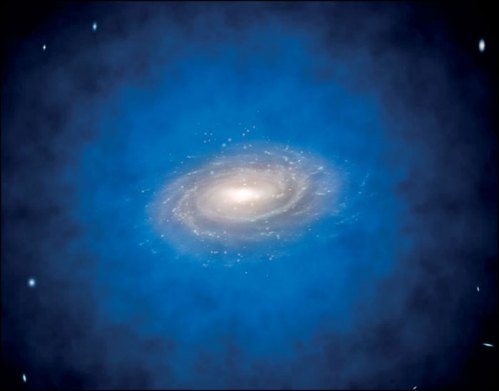
At the heart of almost every galaxy lurks a monster — a supermassive black hole millions or even billions of times the mass of the sun. Astronomers are still trying to figure out how these enormous beasts form, and whether they are formed before or after the galaxies which surround them. Now, new research suggests that their formation could be related to another of astronomy’s great mysteries: Dark matter.
Most black holes form when large stars collapse to a point at which they have a very large amount of mass in a small volume. But using modeling, a team has investigated what would happen in a stable galactic core made of dark matter, surrounded by a dark matter halo. They found that the center of the dark matter region could become so dense that it would collapse into a supermassive black hole.
Dark matter halos are inferred to exist around galaxies, and even though they are invisible to us they seem to contain more mass than the regular matter of a typical galaxy. But to collapse and form a supermassive black hole, the study found that the halo would need to be of a certain size — larger than those found around dwarf galaxies, for example.
“This model shows how dark matter halos could harbor dense concentrations at their centers, which may play a crucial role in helping to understand the formation of supermassive black holes,” said Carlos R. Argüelles, lead author, in a statement. “Here we’ve proven for the first time that such core–halo dark matter distributions can indeed form in a cosmological framework, and remain stable for the lifetime of the Universe.”
The model also suggests that this method would allow black holes to form quickly, even before the galaxies that surround them. This goes against a current theory that says that galaxies likely formed first in the early universe, and then supermassive black holes formed inside them.
This could help to explain how the earliest supermassive black holes formed in the early universe, when they weren’t many stars around, Argüelles said: “This new formation scenario may offer a natural explanation for how supermassive black holes formed in the early Universe, without requiring prior star formation or needing to invoke seed black holes with unrealistic accretion rates.”
Editors' Recommendations
- Biggest stellar black hole to date discovered in our galaxy
- Is dark energy changing over time? A new survey suggests it could be
- Asimov’s vision of harvesting solar power from space could become a reality
- Scientists want your help to search for black holes
- James Webb finds that rocky planets could form in extreme radiation environment